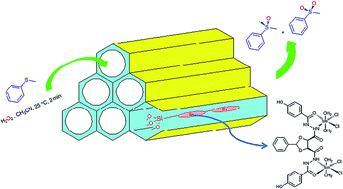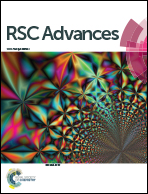A highly efficient, enantioselective and recyclable mesoporous silica-based Mn(ii) catalyst for asymmetric oxidation of thioanisole
Abstract
The development of environmentally benign reactions is an important goal in synthetic organic chemistry and chemical engineering. However, catalytic enantioselective oxidations using transition-metal complexes are limited when the oxidant is hydrogen peroxide. A hydrazone based asymmetric ligand (H2L) was used to prepare a heterogeneous catalyst by the immobilization of its manganese complex, [{Mn(H2O)2Cl2}2(H2Btar)] (1), on mesoporous support SBA-15 via the post grafting method (H2L = 2,3-O-4-hydroxybenzhydrazidebenzylidene-D-tartrate). The heterogeneous asymmetric catalyst 1-SBA15 was characterized by elemental analysis; small angle X-ray diffraction (SAX), scanning electron microscopy (SEM), nitrogen sorption measurement, Fourier transform infrared spectroscopy and EPR spectroscopy. The asymmetric oxidation of thioanisole (PhSMe) was achieved with hydrogen peroxide in the presence of 1-SBA15 in excellent conversion and enantioselectivity (>99% ee). Compared to a homogeneous catalyst, the heterogenized catalyst is more stable and can be recycled four times without any significant loss of activity. Immobilization of complex 1 onto SBA-15 increased the selectivity toward sulfone in the oxidation.


 Please wait while we load your content...
Please wait while we load your content...